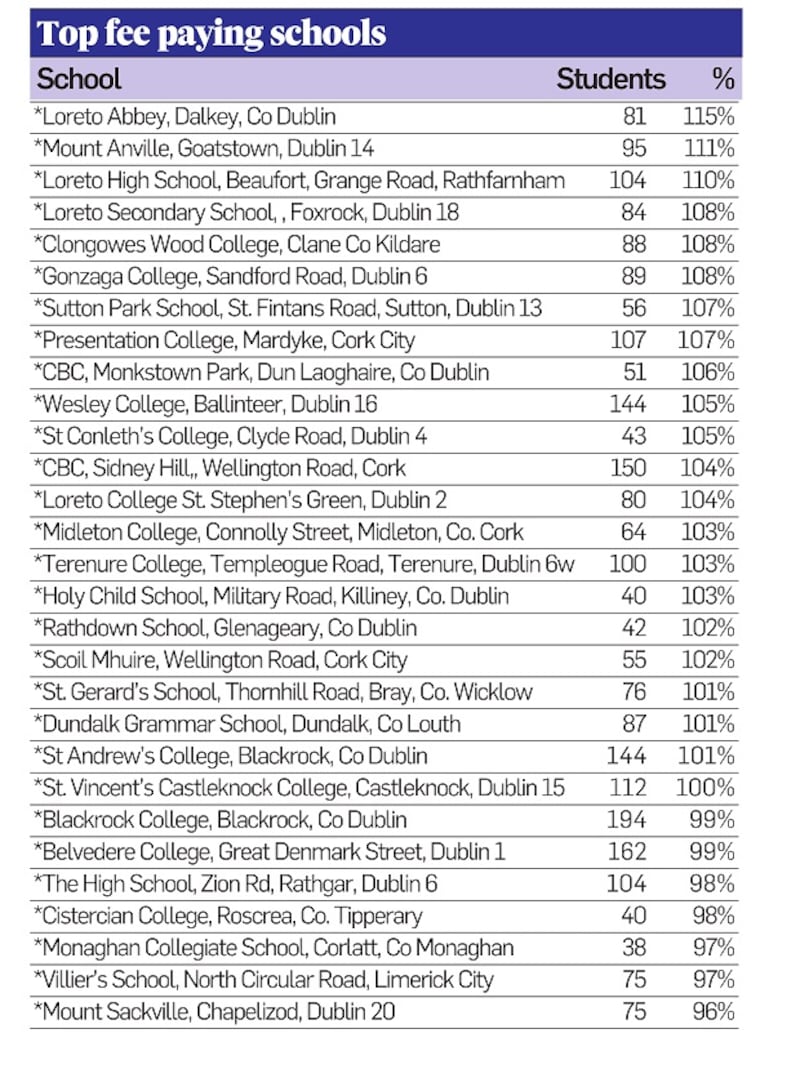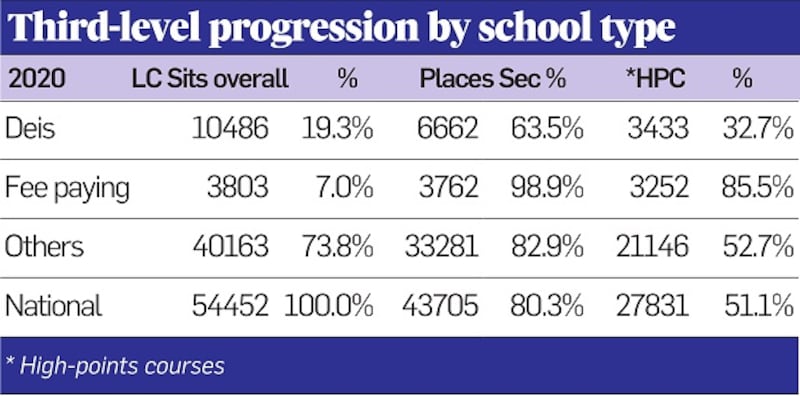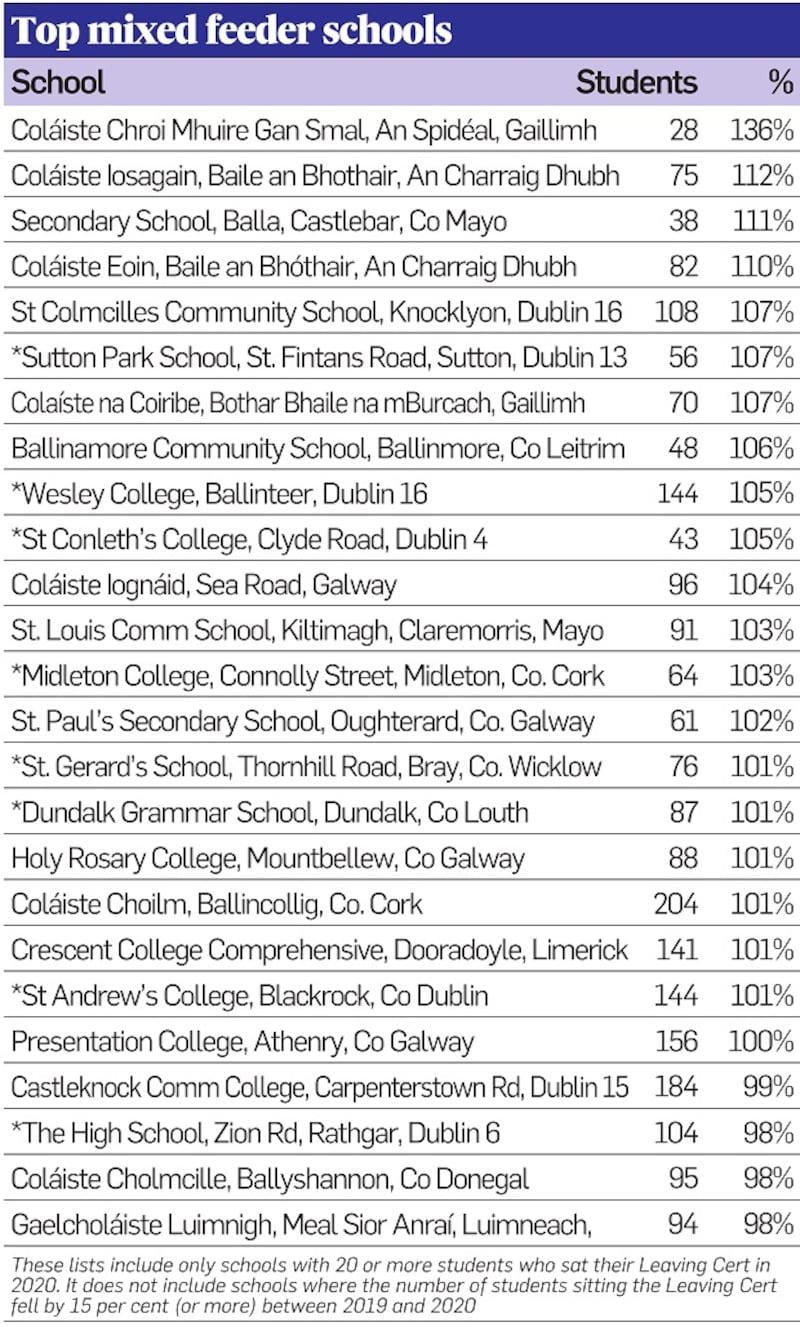[ Click here to downloadOpens in new window ]
Students from fee-paying schools and wealthier parts of south Dublin continue to have a strong advantage in accessing third-level places, according to figures published in Friday's annual Feeder School supplement.
However, some Deis-designated schools have seen significantly higher numbers progress to third-level this year.
Over 25 per cent of those securing places in UCD (1,000) and Trinity College (638) in 2020 sat their Leaving Cert in a fee-paying school.
This amounts to 43 per cent of the 3,803 sixth-year students from fee-paying schools who were awarded calculated grades in September 2020.
The progression figure also includes students who sat the Leaving Cert in previous years, which can be up to 20 per cent of successful applicants in a normal year.
The data comes as the High Court considers a lead challenge from a Belvedere College Leaving Cert student over the Minister for Education's decision to exclude historical school data from the calculated grades process.
In particular, fee-paying schools have tightened their grip on high-points courses (courses at universities, teacher training colleges and RCSI), taking 28 of the top 50 places in 2020 compared to 23 in 2019.
Pre-2020 Leaving Cert students
One of the major criticisms of the calculated grades process was that grade inflation – which led to higher CAO points – disadvantaged more than 10,000 students who had applied on the basis of results secured in previous years.
Our list shows progression percentages with some schools of over 100 per cent of the 2020 Leaving Cert class total. Of course, no school sends 100 per cent of their student body to third-level in any given year. However, when you factor in former students plus other applicants (students who deferred entry, or dropped out of an existing course and reapplied for a new programme, or who secured a place through the further education reserved places route), the total number of successful college registrations sometimes exceeds the total number of students who completed the Leaving Cert cycle that year.
In 2020, some of those schools with progression rates in excess of the total of their 6th year cohort have seen numbers falling to just over 100 per cent, suggesting that some previous applicants – particularly those from fee-paying schools – may indeed have lost out on third-level places.
It has been estimated that 15 per cent fewer students from previous years progressed to CAO programmes in 2020 than would be usual in a normal year.
For example, in 2019, five fee-paying schools in Dublin 6 saw more students secure a place than they had 6th year students that year. In 2020 only one of them had. In Co Cork, however, 10 schools had a progression rate of over 100 per cent in 2019; this year, 11 do.
Elsewhere, some other schools – including Wesley College in Dublin 16 and Ursuline College Sligo – have seen their 100 per cent-plus progression numbers actually rise.
The general high level of satisfaction of the 2020 applicants is due in no small part to the 2,245 additional CAO places announced by Minister for Further and Higher Education Simon Harris in the days prior to round one offers in September.


Additional places
Some 2,744 additional level 8 places were offered and accepted in 2020 while the number of level 6/7 places offered saw a drop of 499.
However, some schools have inevitably been harder hit than others, while a number of disadvantaged schools (Deis) have seen access increase.
Looked at over the past six years (2014-2020), the proportion and numbers of students from Deis schools who have secured places in high-points courses and colleges has increased from 2,410 (24.2 per cent) to 3,433 (32.7 per cent) in 2020.
Over 400 of that increase occurred in 2020, indicating that Deis schools benefitted significantly from the calculated grades process.
The total number of Deis students who secured places in high-points programmes in 2020 exceeded by 181 the numbers who did so from fee-paying schools.
This is not quite the revolution it may seem, and significant differences persist in educational achievements between students in Deis and non-Deis schools, with close to three times as many students (19.3 per cent) attending Deis schools as do those in fee-paying schools (7 per cent).
Mercy College in Inchicore had an overall progression rate of 69 per cent in 2019. This increased to 113 per cent in 2020. Other similar examples include New Cross College in Finglas increasing from 45 to 160 per cent. In Dublin 24 (Tallaght and Jobstown), significantly higher numbers have gone on to third-level this year. At Nagle Community College in Cork, third-level progression has risen from 29 to 50 per cent.
Such data indicates beyond refute that the investment in Deis schools since the inception of the programme in 2005 is leading to a major increase in progression to college through both direct entry after the Leaving Cert and through FE routes.
It is also clear that 2020 saw an increase in Deis schools’ success rates, which would give rise to the question of how to maintain these advances when the exam system moves back to the traditional Leaving Cert exams as the sole criteria for the allocation of places.
Belvedere College in Dublin 1 was one of the highest-profile fee-paying schools where students have complained about being disadvantaged by the calculated grades process. The proportion of successful applicants represented 99 per cent of this year’s sixth-year class numbers at Belvedere, whereas in 2019 the number was 117 per cent as a proportion of that year’s class group.
St Kilian’s, which has for generations served the German community in Dublin and therefore has traditionally secured H1s across the board in German for these native-speaking students, was disappointed when only 14 per cent of its students achieved a H1 in German.
This outcome was based on the algorithm devised by the Department of Education which did not take account of the unique nature of the German language ability of the school’s students.
Many students, having decided not to accept a lower offer, sat the Leaving Cert German paper in November and are awaiting their results, which may determine whether they receive a higher-preference offer from their 2020 CAO choices, which they can then commence in September 2021.
The Irish Times understands that at least eight St Kilian’s students are studying or on a gap year in the EU, while one is doing a PLC course. The school’s principal, Alice Lynch, says that 53 per cent of Kilian’s students were negatively affected by the changes this year, so a further number deferred their college places or sat the written exam in November.
None of these students are included in our third-level progression statistics as we are unable to count students who study abroad, while those who sat their Leaving Cert exam in November will not be offered places until the 2021 CAO offers are issued.

Mixed schools and girls’ schools outperform boys’ schools. Of the top 20 girls’ and top 20 mixed schools, all saw progression percentages of over 100 per cent. In the case of the top 20 single-sex boys’ schools, 11 had progression rates of over 100 per cent as a proportion of this year’s sixth-year class numbers.
Outside of the fee-paying sector, Irish-medium schools performed strongly again, taking three of the top 10 places in the main progression table this year.
One, Coláiste Chroí Mhuire gan Smal, is located in An Spidéal, in the Connemara Gaeltacht, while the other two schools are located in Dublin.
While Irish-medium schools may be over-represented relative to other schools at the top of these education charts, they are few in number and lag behind other types of schools when it comes to their distribution and availability nationwide (just 49, or 6.7 per cent, of the country’s 723 post-primary schools teach all subjects through Irish).
Increased awareness of the advantages of bilingualism combined with demand from Irish-medium schools at primary level have contributed to increased pressure for more Irish-medium education places at secondary level.
The continued presence of Irish-medium secondary schools at the upper end of these progression charts will be no surprise to those who are calling for the development and prompt rollout of a dedicated Government policy for Irish-medium education.
Summary
Despite the unique challenges faced by the class of 2020, grades awarded through the calculated grades process were over 4 per cent higher than 2019 levels, and those awarded for higher-level papers were 10 per cent ahead.
The class of 2020 were uniquely advantaged over applicants from previous years, and, with more than 2,000 extra places on offer, more current-year Leaving Cert students secured places than would normally do so. This is particularly true in Deis schools, where the calculated grades process seems to have worked to their advantage.
Those who lost out in this year’s competition were pre-Leaving Cert 2020 applicants who missed out on places due to the points increases driven by the higher grades awarded under the calculated grades process.












